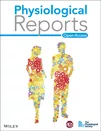Abstract The steady‐state isometric force following active muscle shortening or lengthening is smaller (force depression, FD) or greater (residual force enhancement, RFE) than a purely isometric contraction at the corresponding length. The mechanism underlying these phenomena is not explained within the context of the cross‐bridge theory, with few studies investigating the effects of FD and RFE in stretching–shortening cycle (SSC). The purpose of this study was to perform SSC, where the time between the end of stretch and the end of shortening was manipulated by (1) adding a pause between stretch and shortening (protocol 1) or (2) performing the shortening contraction at different speeds (protocol 2). The results show that, in protocol 1, FD was reduced for SSC with a 0‐sec and 0.5‐sec interval between stretching and shortening, but was the same for SSC with a 1‐sec interval compared to the pure FD condition. In protocol 2, FD was reduced for SSC with shortening speeds of 30 and 60°/sec, but was the same for shortening speeds of 15 and 20°/sec compared to the pure FD condition. These findings provide evidence that stretch preceding shortening affects FD in a time‐ and speed‐dependent manner, providing new information on the potential mechanism of FD and RFE.
Author Information:
Rafael Fortuna 1, Martin Groeber2, Wolfgang Seiberl2, Geoffrey A. Power3 and Walter Herzog1
1 Human Performance Laboratory, Faculty of Kinesiology, University of Calgary, Calgary, Canada
2 Department of Biomechanics in Sports, Faculty of Sport and Health Sciences, Technische Universität München, Munich, Germany
3 Neuromechanical Performance Research Lab, Department of Human Health and Nutritional Sciences, College of Biological Sciences University of Guelph, Guelph Ontario, Canada
